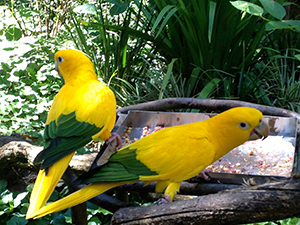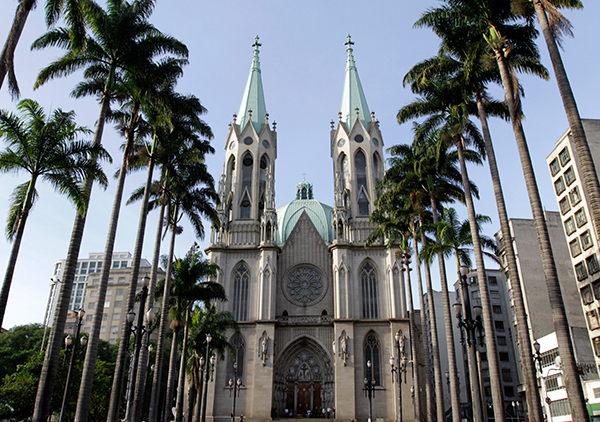The Magic of Iguazu Falls & Sao Paulo

By Jon Haggins Photos by David Fasano
Iguazu Falls is located in the glorious country of Brazil and is considered one of the Seven Natural Wonders of the world and a UNESCO Natural Wonder of the World since 1986. It’s the largest waterfall in the world. It’s a spectacular site where a rainbow sits on the shoulders of the falls. What a sight to see! You can take a boat ride under the falls, but be prepared to get soaked. It’s amazing! Iguazu is a magical and wet experience. A walkway is suspended over the bottom of the falls and offers a spectacular view. It’s where everyone gets drenched from the never-ending refreshing shower. It’s a perfect place for lovers to enjoy the spectacular view. There are seven luscious falls shared by Paraguay, Argentina and Brazil. Some folks come to renew their vows and replenish their energy. It’s perfect for everyone!

The Bird Park, owned by a private company is where you can find 130 different species totaling more than 1,000 birds. Fifty percent of the birds come from The International Traffic Environmental Authority. They arrive in bad condition and receive treatment. Some are endangered, especially the Brazilian birds. Many of them are caught when they are chicks. If let go, they will probably die because they don’t know how to fend for themselves.
The Bird Park is where one can see exotic birds like the Brazilian Macaw and other protected birds. The bird sanctuary also has a collection of butterflies and flamingos from Africa and Chile. In order for flamingos to reproduce, they like to be in big groups, which provides safety. Baby flamingos are grey in color and as they grow they change to pink as a result of eating shrimp of that color. As adults, color is very important for mating.
Bufalo Branco-Churrascaria Restaurant Barbecue House offers twenty-five different meats. It’s the best steak house in Iguazu. First you start at the salad bar with a variety of choices. Then you must order the traditional Brazilian drink, the caipirinha (cachaca, fresh limes and sugar on the rocks). The selection of meats include chicken, lamb, pork and lots of beef. Waiters arrive at each table to slice the meats of your choice. The picanhas is a rump cut and it’s ooh so delicious. It comes from the rear of the steer (or heifer) and is the most sought-after piece of meat in Brazil. The meat is moist with the simplest seasoning of sea salt. You don’t need to add anything because the meat is so tender.
My favorite side dish was a pineapple dipped in cinnamon and then put in a rotisserie for five minutes. The pineapple was fresh and juicy, not like the pineapple we get in our supermarket. The cinnamon added another dimension.
The local entertainment is colorful and energetic such as the Capoeira, which is a marshal art cartwheel dance that was developed during slavery because men weren’t allowed to fight with their hands. And of course, what is Brazil without Carmen Miranda? Several ladies performed one of Carmen’s numbers on stage. It was an eventful evening.
Sao Paulo, Brazil
Sao Paulo is a metropolis of twenty million people. The Brits built the Grand Luz Station, the central hub for trains and subways and is a copy of a station in Scotland. In 1800, Sao Paulo was the major producer of coffee for Brazil. Coffee was known as Black Gold. Sao Paulo no longer produces coffee. Today the major product is sugar cane. The Museum of Language is a part of the train station and shares the history of the Portuguese language with its roots integrated with native African influence in Brazil.
In 1908 the first wave of Japanese came to Brazil as laborers. Liberdade (means Liberty) is the largest Japanese community outside of Japan. The neighborhood was built and preserved for the Japanese. Liberty Square was once used as a Pellourinho (whipping post), but no longer. Today you can shop for fresh produce and great food. It’s filled with restaurants, shops, a church and arts and crafts. It’s now a public square where people meet and socialize. It’s also a place to be seen. Sao Paulo also has African, Jewish, Arab, Lebanese and Italian communities. The people of Brazil are such a mix like a Feijoada stew. Feijoada is a mixture of beans with beef and pork, a typical Portuguese dish.
St. Paulista Cathedral is a New Gothic design built in 1954, but it looks older. The stained glass windows remind me of patterns on old lace curtains. Rows of royal palms line the plaza, which is surrounded by classical buildings.

The Financial Center has converted some of its old buildings into cultural centers. The Banco do Brazil building is an example of a conversion into an art museum which brings music and art alive. A large bust sits at the doorstep and a modern tire sculpture streams down the facade. The first skyscraper stands in the historic district. Martinelli Building began construction in 1927 and was dedicated in 1930 with only 12 floors completed. In 1934 eight more floors were added for a total of twenty floors.
Paulista Avenue is the main financial avenue. The Museum of Modernism or the São Paulo Museum of Art has a collection of contemporary works of Brazilian arts and culture. It took twelve years to construct and had to follow a condition imposed by the donor of the land to the city of Sao Paulo. The condition was that the view from downtown should be preserved. In order to respect that condition, four columns with a span of 265 feet were designed to support and raise the building off the ground, creating a large open concourse. The museum is a leading expression of modern art in Brazil. It is a must see when visiting Sao Paulo. Madalena is an artistic, hippie district where the walls are filled with colorful murals expressing the life of the neighborhood. Famous Brazilian artists have painted the colorful murals.
During the weekend an artist’s craft market is set up in a square where you can find unusual items and treasures. Madalena is also where you’ll find numerous restaurants offering great dining experiences.
The last evening was energetic with another fantastic dinner and entertainment by Carlinhos de Jesus, a well-known entertainer in Sao Paulo. He wore a white suit with a horizontal black and white crew neck shirt as he danced and sang with his samba band and sexy samba-dancing ladies. They reflected the energy and excitement of Sao Paulo.
Editor’s Note: Check out Jon’s interestingly named book Chasing Wild ASS. Oooooh, it’s not what you’re thinking. Chasing Wild ASS is a narrative of his travels to more than 60 countries around the world. The title came about while chasing jackasses in Kutch Wild Ass Sanctuary in Gujarat, India. Chasing Wild ASS will entertain and offer tips to massage your soul. It’s a celebration of life. Get an autographed copy of Chasing Wild ASS. 489 pages including color photos and recipes. Paperback ISBN: 978-0-578-13897-8, $19.95 plus $5.00 S&H. Jon Haggins, PO Box 20902, New York, NY 10023.
With any questions please email:
jonhaggins@aol.com


